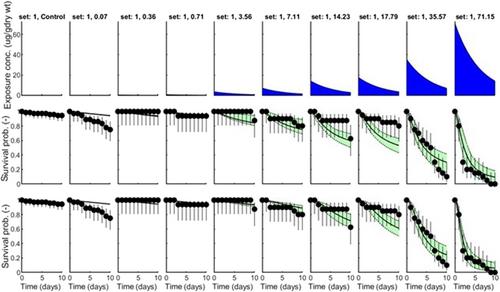Sara Nicoline Grønlund, Casper D. Læssøe, Nina Cedergreen, Henriette Selck
下载PDF
{"title":"在评估沉积物相关药物对片脚类动物的毒性时纳入不同暴露浓度的重要性","authors":"Sara Nicoline Grønlund, Casper D. Læssøe, Nina Cedergreen, Henriette Selck","doi":"10.1002/etc.5894","DOIUrl":null,"url":null,"abstract":"<p>Pharmaceuticals have been classified as an environmental concern due to their increasing consumption globally and potential environmental impact. We examined the toxicity of sediment-associated diclofenac and citalopram administered as both single compounds and in a mixture to the sediment-living amphipod <i>Corophium volutator</i>. This laboratory-based study addressed the following research questions: (1) What is the toxicity of sediment-associated diclofenac and citalopram to <i>C. volutator</i>? (2) Can the mixture effect be described with either of the two mixture models: concentration addition (CA) or independent action (IA)? (3) What is the importance of the choice of (i) exposure measure (start concentration, time-weighted average [TWA], full exposure profile) and (ii) effect model (concentration–response vs. the toxicokinetic–toxicodynamic model general unified threshold model for survival in its reduced form [GUTS-RED]) for the derived effect concentration values? Diclofenac was more toxic than citalopram to <i>C. volutator</i> as a single compound (10-day exposure). Diclofenac exposure to <i>C. volutator</i> provided median lethal concentrations (LC50s) within the same range (11 µg g<sup>−1</sup> dry wt sediment) using concentration–response based on TWA and both GUTS-RED models. However, concentration–response based on measured start concentrations provided an approximately 90% higher LC50 (21.6 ± 2.0 µg g<sup>−1</sup> dry wt sediment). For citalopram, concentration–response parameters were similar regardless of model or concentration used (LC50 85–97 µg g<sup>−1</sup> dry wt sediment), however, GUTS-RED with the assumption of individual tolerance resulted in a lower LC50 (64.9 [55.3–74.8] µg g<sup>−1</sup> dry wt sediment). The mixture of diclofenac and citalopram followed the CA quite closely, whereas the result was synergistic when using the IA prediction. In summary, concentration–response based on TWA and GUTS-RED provided similar and reasonably good fits compared to the data set. The implications are that GUTS-RED will provide a more flexible model, which, in principle, can extend beyond the experimental period and make predictions based on variable exposure profiles (toxicity at different time frames and at different variable exposure scenarios) compared to concentration–response, which provides contaminant toxicity at one point in time. <i>Environ Toxicol Chem</i> 2024;43:1767–1777. © 2024 The Authors. <i>Environmental Toxicology and Chemistry</i> published by Wiley Periodicals LLC on behalf of SETAC.</p>","PeriodicalId":11793,"journal":{"name":"Environmental Toxicology and Chemistry","volume":"43 8","pages":"1767-1777"},"PeriodicalIF":2.8000,"publicationDate":"2024-05-28","publicationTypes":"Journal Article","fieldsOfStudy":null,"isOpenAccess":false,"openAccessPdf":"https://onlinelibrary.wiley.com/doi/epdf/10.1002/etc.5894","citationCount":"0","resultStr":"{\"title\":\"The Importance of Including Variable Exposure Concentrations When Assessing Toxicity of Sediment-Associated Pharmaceuticals to an Amphipod\",\"authors\":\"Sara Nicoline Grønlund, Casper D. Læssøe, Nina Cedergreen, Henriette Selck\",\"doi\":\"10.1002/etc.5894\",\"DOIUrl\":null,\"url\":null,\"abstract\":\"<p>Pharmaceuticals have been classified as an environmental concern due to their increasing consumption globally and potential environmental impact. We examined the toxicity of sediment-associated diclofenac and citalopram administered as both single compounds and in a mixture to the sediment-living amphipod <i>Corophium volutator</i>. This laboratory-based study addressed the following research questions: (1) What is the toxicity of sediment-associated diclofenac and citalopram to <i>C. volutator</i>? (2) Can the mixture effect be described with either of the two mixture models: concentration addition (CA) or independent action (IA)? (3) What is the importance of the choice of (i) exposure measure (start concentration, time-weighted average [TWA], full exposure profile) and (ii) effect model (concentration–response vs. the toxicokinetic–toxicodynamic model general unified threshold model for survival in its reduced form [GUTS-RED]) for the derived effect concentration values? Diclofenac was more toxic than citalopram to <i>C. volutator</i> as a single compound (10-day exposure). Diclofenac exposure to <i>C. volutator</i> provided median lethal concentrations (LC50s) within the same range (11 µg g<sup>−1</sup> dry wt sediment) using concentration–response based on TWA and both GUTS-RED models. However, concentration–response based on measured start concentrations provided an approximately 90% higher LC50 (21.6 ± 2.0 µg g<sup>−1</sup> dry wt sediment). For citalopram, concentration–response parameters were similar regardless of model or concentration used (LC50 85–97 µg g<sup>−1</sup> dry wt sediment), however, GUTS-RED with the assumption of individual tolerance resulted in a lower LC50 (64.9 [55.3–74.8] µg g<sup>−1</sup> dry wt sediment). The mixture of diclofenac and citalopram followed the CA quite closely, whereas the result was synergistic when using the IA prediction. In summary, concentration–response based on TWA and GUTS-RED provided similar and reasonably good fits compared to the data set. The implications are that GUTS-RED will provide a more flexible model, which, in principle, can extend beyond the experimental period and make predictions based on variable exposure profiles (toxicity at different time frames and at different variable exposure scenarios) compared to concentration–response, which provides contaminant toxicity at one point in time. <i>Environ Toxicol Chem</i> 2024;43:1767–1777. © 2024 The Authors. <i>Environmental Toxicology and Chemistry</i> published by Wiley Periodicals LLC on behalf of SETAC.</p>\",\"PeriodicalId\":11793,\"journal\":{\"name\":\"Environmental Toxicology and Chemistry\",\"volume\":\"43 8\",\"pages\":\"1767-1777\"},\"PeriodicalIF\":2.8000,\"publicationDate\":\"2024-05-28\",\"publicationTypes\":\"Journal Article\",\"fieldsOfStudy\":null,\"isOpenAccess\":false,\"openAccessPdf\":\"https://onlinelibrary.wiley.com/doi/epdf/10.1002/etc.5894\",\"citationCount\":\"0\",\"resultStr\":null,\"platform\":\"Semanticscholar\",\"paperid\":null,\"PeriodicalName\":\"Environmental Toxicology and Chemistry\",\"FirstCategoryId\":\"93\",\"ListUrlMain\":\"https://onlinelibrary.wiley.com/doi/10.1002/etc.5894\",\"RegionNum\":4,\"RegionCategory\":\"环境科学与生态学\",\"ArticlePicture\":[],\"TitleCN\":null,\"AbstractTextCN\":null,\"PMCID\":null,\"EPubDate\":\"\",\"PubModel\":\"\",\"JCR\":\"Q2\",\"JCRName\":\"ENVIRONMENTAL SCIENCES\",\"Score\":null,\"Total\":0}","platform":"Semanticscholar","paperid":null,"PeriodicalName":"Environmental Toxicology and Chemistry","FirstCategoryId":"93","ListUrlMain":"https://onlinelibrary.wiley.com/doi/10.1002/etc.5894","RegionNum":4,"RegionCategory":"环境科学与生态学","ArticlePicture":[],"TitleCN":null,"AbstractTextCN":null,"PMCID":null,"EPubDate":"","PubModel":"","JCR":"Q2","JCRName":"ENVIRONMENTAL SCIENCES","Score":null,"Total":0}
引用次数: 0
引用
批量引用


 求助内容:
求助内容: 应助结果提醒方式:
应助结果提醒方式:


